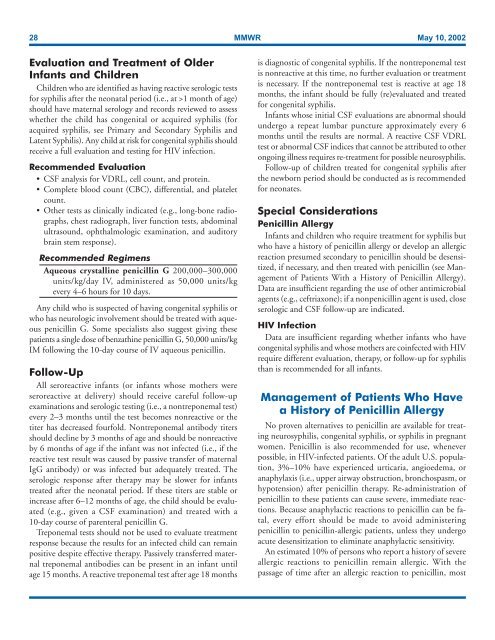You also want an ePaper? Increase the reach of your titles
YUMPU automatically turns print PDFs into web optimized ePapers that Google loves.
28 MMWR May 10, 2002<br />
Evaluation and Treatment of Older<br />
Infants and Children<br />
Children who are identified as having reactive serologic tests<br />
for syphilis after the neonatal period (i.e., at >1 month of age)<br />
should have maternal serology and records reviewed to assess<br />
whether the child has congenital or acquired syphilis (for<br />
acquired syphilis, see Primary and Secondary Syphilis and<br />
Latent Syphilis). Any child at risk for congenital syphilis should<br />
receive a full evaluation and testing for HIV infection.<br />
Recommended Evaluation<br />
CSF analysis for VDRL, cell count, and protein.<br />
Complete blood count (CBC), differential, and platelet<br />
count.<br />
Other tests as clinically indicated (e.g., long-bone radiographs,<br />
chest radiograph, liver function tests, abdominal<br />
ultrasound, ophthalmologic examination, and auditory<br />
brain stem response).<br />
Recommended Regimens<br />
Aqueous crystalline penicillin G 200,000–300,000<br />
units/kg/day IV, administered as 50,000 units/kg<br />
every 4–6 hours for 10 days.<br />
Any child who is suspected of having congenital syphilis or<br />
who has neurologic involvement should be treated with aqueous<br />
penicillin G. Some specialists also suggest giving these<br />
patients a single dose of benzathine penicillin G, 50,000 units/kg<br />
IM following the 10-day course of IV aqueous penicillin.<br />
Follow-Up<br />
All seroreactive infants (or infants whose mothers were<br />
seroreactive at delivery) should receive careful follow-up<br />
examinations and serologic testing (i.e., a nontreponemal test)<br />
every 2–3 months until the test becomes nonreactive or the<br />
titer has decreased fourfold. Nontreponemal antibody titers<br />
should decline by 3 months of age and should be nonreactive<br />
by 6 months of age if the infant was not infected (i.e., if the<br />
reactive test result was caused by passive transfer of maternal<br />
IgG antibody) or was infected but adequately treated. The<br />
serologic response after therapy may be slower for infants<br />
treated after the neonatal period. If these titers are stable or<br />
increase after 6–12 months of age, the child should be evaluated<br />
(e.g., given a CSF examination) and treated with a<br />
10-day course of parenteral penicillin G.<br />
Treponemal tests should not be used to evaluate treatment<br />
response because the results for an infected child can remain<br />
positive despite effective therapy. Passively transferred maternal<br />
treponemal antibodies can be present in an infant until<br />
age 15 months. A reactive treponemal test after age 18 months<br />
is diagnostic of congenital syphilis. If the nontreponemal test<br />
is nonreactive at this time, no further evaluation or treatment<br />
is necessary. If the nontreponemal test is reactive at age 18<br />
months, the infant should be fully (re)evaluated and treated<br />
for congenital syphilis.<br />
Infants whose initial CSF evaluations are abnormal should<br />
undergo a repeat lumbar puncture approximately every 6<br />
months until the results are normal. A reactive CSF VDRL<br />
test or abnormal CSF indices that cannot be attributed to other<br />
ongoing illness requires re-treatment for possible neurosyphilis.<br />
Follow-up of children treated for congenital syphilis after<br />
the newborn period should be conducted as is recommended<br />
for neonates.<br />
Special Considerations<br />
Penicillin Allergy<br />
Infants and children who require treatment for syphilis but<br />
who have a history of penicillin allergy or develop an allergic<br />
reaction presumed secondary to penicillin should be desensitized,<br />
if necessary, and then treated with penicillin (see Management<br />
of Patients With a History of Penicillin Allergy).<br />
Data are insufficient regarding the use of other antimicrobial<br />
agents (e.g., ceftriaxone); if a nonpenicillin agent is used, close<br />
serologic and CSF follow-up are indicated.<br />
HIV Infection<br />
Data are insufficient regarding whether infants who have<br />
congenital syphilis and whose mothers are coinfected with HIV<br />
require different evaluation, therapy, or follow-up for syphilis<br />
than is recommended for all infants.<br />
Management of Patients Who Have<br />
a History of Penicillin Allergy<br />
No proven alternatives to penicillin are available for treating<br />
neurosyphilis, congenital syphilis, or syphilis in pregnant<br />
women. Penicillin is also recommended for use, whenever<br />
possible, in HIV-infected patients. Of the adult U.S. population,<br />
3%–10% have experienced urticaria, angioedema, or<br />
anaphylaxis (i.e., upper airway obstruction, bronchospasm, or<br />
hypotension) after penicillin therapy. Re-administration of<br />
penicillin to these patients can cause severe, immediate reactions.<br />
Because anaphylactic reactions to penicillin can be fatal,<br />
every effort should be made to avoid administering<br />
penicillin to penicillin-allergic patients, u<strong>nl</strong>ess they undergo<br />
acute desensitization to eliminate anaphylactic sensitivity.<br />
An estimated 10% of persons who report a history of severe<br />
allergic reactions to penicillin remain allergic. With the<br />
passage of time after an allergic reaction to penicillin, most


